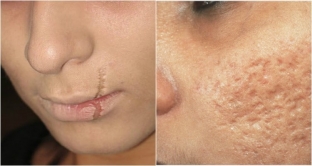One of the most difficult areas in cosmetology – it's scar work. This aesthetic defect always requires an integrated approach, correction takes a long time and, unfortunately, does not always lead to the desired results. In response to the patient's question about how to get rid of scars, it is necessary to assess the risks of cosmetic intervention, determine the type of scar tissue, find out when and under what circumstances the scar formed, and collect a detailed history before starting therapy. Good results in working with scar tissue were shown by hyaluronidase, administered both by injection and by electrophoresis. Read more about this at estet-portal.com.
How to get rid of scars with injections: what makes them effective
Hyaluronidase is an enzyme capable of breaking down hyaluronic acid molecules. The use of this enzyme in cosmetic practice is widely known, when it becomes necessary to correct side effects after the introduction of fillers based on hyaluronic acid. However, hyaluronidase has found its application in working with scar tissue.
With the introduction of hyaluronidase in tissues, the permeability of cell membranes and vascular walls increases. Excess moisture begins to be removed from the intercellular space, microcirculation improves, the density of scar formations decreases
Hyaluronidase shows a good effect when working with those types of scars that have formed due to overgrown connective tissue cells – that is, hypertrophic and keloid. It is important to remember that when using the drug for the correction of atrophic scars, there is a high risk of getting the opposite effect – the scar will retract even more and become more visible than before.
Hyaluronidase injections are made directly into the scar, the effect is especially good in the first few months after the scar tissue has formed at the site of the wound. Older scars respond less well to hyaluronidase, but even they are significantly reduced in size and their appearance improves after the procedure.
For the treatment of hypertrophic scars, even 1-3 sessions are enough to get the desired result. But when working with keloid scars, it will not be possible to eliminate the aesthetic defect with only a few injections of hyaluronidase. This is due to the peculiarity of keloid tissue, the growth of which is due to increased activity in the skin of fibroblasts. The desired effect can be achieved only in combination, sometimes you have to add steroid injections and even resort to surgical excision of the keloid scar.
Therapy of scars with the use of hyaluronidase requires high qualifications from the doctor, because an incorrectly calculated dose of the drug when injected can provoke a noticeable retraction of the corrected scar and the formation of a new defect.
Read also: Scar correction, how to choose the right method

How to get rid of scars with hyaluronidase electrophoresis
Introduce hyaluronidase into the scar tissue using mild electric current pulses.
The electrophoresis procedure allows the active substance of hyaluronidase to pass through the skin very easily and gently. The advantage of such an introduction – in absolute non-invasiveness and complete controllability of the process
A significant disadvantage of scar tissue correction using hyaluronidase electrophoresis is that the result can only be assessed after the full course of treatment is completed: usually 3 to 10 procedures are required depending on the type, size and condition of the scar, which are carried out at intervals of 2 days.
The electrophoresis procedure with hyaluronidase for the correction of cicatricial deformities is carried out as follows:
- a special pad is impregnated with a solution that includes hyaluronidase and, at the doctor's choice, other active substances (for example, Ronidase);
- concentration of the solution is determined individually for each patient, depending on the characteristics of the corrected scar;
- the pad is placed on the scar tissue, an electrode is fixed to it, through which a constant electrical discharge of low power is supplied;
- The duration of the session is 15-20 minutes, the patient may feel a slight tingling in the area where the pad contacts the skin.
Immediately after the completion of the hyaluronidase electrophoresis procedure, the patient can go home. This method of scar tissue therapy is considered one of the safest. According to the indications, it can be recommended even to small children, and they achieve good results much faster than adults.







Add a comment